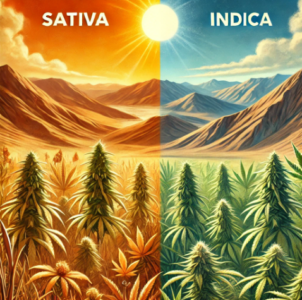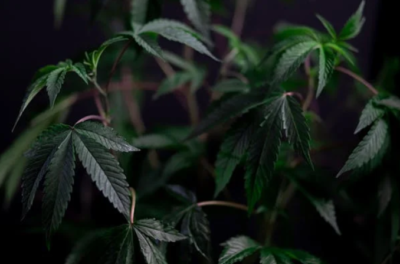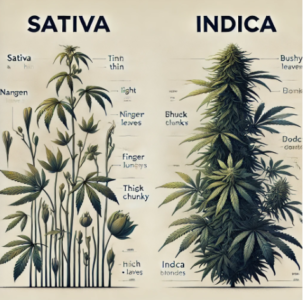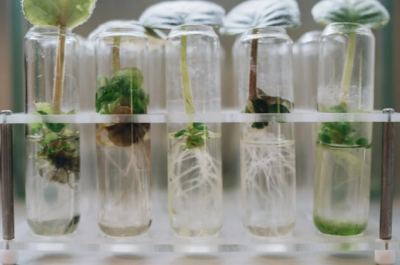Sativa vs Indica a debate that has intrigued both new and seasoned cannabis users for decades. These two primary strains of cannabis hold distinct reputations, with Sativa known for its energizing effects and Indica for its calming properties. But as cannabis use continues to grow, so does the complexity of choosing the right strain.
It’s no longer just about picking a name off the shelf. With over 1,000 strains available, each boasting unique effects, finding the right fit for your needs can feel overwhelming.
Despite common beliefs, the differences between Sativa vs Indica may not be as straightforward as they seem. While Sativa is often associated with creativity and energy, and Indica with relaxation and sleep, these distinctions can sometimes be oversimplified.
Modern research suggests that other factors, such as terpene profiles and cannabinoid ratios, play a crucial role in how each strain affects the body.
In this guide, we’ll unravel the complexities of Sativa vs Indica, helping you make an informed decision based on your specific needs.
Whether you’re looking to boost your energy, unwind after a long day, or find the right medical relief, understanding these strains is key to maximizing your cannabis experience.
Which Comes Out on Top in Sativa vs Indica Comparison?
| Sr # | Features | Sativa | Indica | Better Option (Score/5) |
| 1 | Origin | Warm, sunny climates (Africa, Southeast Asia) | Cooler, harsher climates (Afghanistan, India) | N/A |
| 2 | Plant Description | Tall, thin plants with finger-like leaves | Short, bushy plants with broad leaves | Indica (4.5/5) |
| 3 | Typical Cannabis-to-THC Ratio | Lower Cannabis, higher THC | Higher Cannabis, balanced THC | Indica (4.5/5) |
| 4 | Commonly Associated Effects | Energizing, cerebral “mind high” | Relaxing, sedative “body high” | Sativa (4.5/5) |
| 5 | Daytime or Nighttime Use | Best for daytime use | Best for nighttime use | N/A |
| 6 | Medical Efficacy | Effective for psychological disorders like depression, PTSD, and anxiety | Effective for physical ailments like pain, inflammation, and insomnia | Indica (4.5/5) |
| 7 | Aroma | Sweet, fruity, or spicy | Earthy, skunky, or musty | Sativa (4/5) |
| 8 | Growth Time | Longer growth period, lower yield | Shorter growth period, higher yield | Indica (4.5/5) |
| 9 | Popular Strains | Durban Poison, Super Silver Haze | Afghan Kush, Granddaddy Purple | N/A |
| 10 | Hybrid Potential | Often used in sativa-dominant hybrids | Often used in indica-dominant hybrids | Indica (4.5/5) |
Sativa vs Indica: Origin

Let’s discuss the origin of indica and sativa. To compare them both we have to discuss them in detail.
Sativa

Sativa strains are primarily found in warm, sunny climates like Africa, Southeast Asia, and Central America. These regions provide the long, sunny days that Sativa plants thrive in.
Sativa has adapted to these environments, developing tall and thin structures with finger-like leaves that allow them to absorb as much sunlight as possible.
The warm climate also influences the plant’s growth cycle, resulting in a longer time to maturity compared to Indica.
This origin is key to understanding the characteristics of Sativa, as the climate and environment where a plant evolves play a significant role in its development and effects.
Indica

Indica strains, on the other hand, originated in the cooler, harsher climates of regions like Afghanistan, India, and Pakistan. These areas, particularly the Hindu Kush mountains, are known for their rough, dry environments. Indica plants have adapted to these conditions by developing short, bushy structures with broad leaves.
This growth pattern allows them to conserve energy and moisture, which is crucial for surviving in less hospitable climates. The harsh conditions also lead to a shorter growth cycle, allowing Indica plants to mature more quickly and produce more buds.
This origin story is crucial for understanding why Indica is often more robust and faster-growing than Sativa.
Sativa vs Indica: Plant Description

Sativa plants are tall and thin with narrow leaves, while Indica plants are short, bushy, and broad-leafed.
Sativa
Sativa plants are characterized by their tall and thin structure, with leaves that are long and narrow, resembling fingers. These plants can reach heights of up to 6 feet (2 meters) or more, making them quite large compared to Indica.
The thin leaves of Sativa plants allow for maximum sunlight absorption, which is essential for their growth in warm, sunny climates. The overall appearance of Sativa is often described as lanky and light, with a more open and airy structure that helps prevent mold and mildew in humid environments.
The plant’s physical characteristics are directly linked to its growth environment, making Sativa ideal for outdoor cultivation in regions with long growing seasons.
Indica
Indica plants are short, stocky, and bushy, with broad, chunky leaves. These plants rarely exceed 4 feet (1.2 meters) in height, making them more compact and easier to manage, especially for indoor cultivation.
The broad leaves of Indica are designed to capture as much light as possible, making them efficient even in less sunny environments. The dense structure of Indica plants allows them to support a large number of buds, contributing to their higher yield compared to Sativa.
The overall appearance of Indica is robust and solid, reflecting its ability to thrive in the tough, mountainous regions of its origin.
This makes Indica a popular choice for growers looking for a plant that produces a substantial harvest in a shorter time.
Sativa vs Indica: Typical Cannabis-to-THC Ratio

Sativa has lower Cannabis and higher THC, while Indica offers a balanced or higher Cannabis-to-THC ratio.
Sativa
Sativa strains are generally known for having lower levels of Cannabis (cannabidiol) and higher levels of THC (tetrahydrocannabinol). This higher THC content is what contributes to the “mind high” that Sativa is famous for, offering an energizing and uplifting effect that enhances creativity and focus.
However, because Sativa has lower Cannabis levels, it may not provide the same level of physical relaxation as Indica. This makes Sativa more suitable for daytime use when you want to stay alert and productive.
The ratio of Cannabis to THC in Sativa can vary, but the focus is typically on maximizing the psychoactive effects that THC provides, making it a popular choice for those looking for a mental boost.
Indica
Indica strains often have a more balanced ratio of Cannabis to THC, with some strains even having higher levels of Cannabis than THC. This balanced ratio is what gives Indica its well-known “body high,” which is deeply relaxing and sedative.
The higher Cannabis content in Indica makes it an excellent choice for treating physical ailments such as pain, inflammation, and insomnia, without the intense psychoactive effects associated with high-THC strains.
This makes Indica ideal for nighttime use when relaxation and sleep are the primary goals. The balanced Cannabis-to-THC ratio in Indica also contributes to its ability to alleviate anxiety and stress, making it a versatile option for medical cannabis users.
Sativa vs Indica: Commonly Associated Effects

Sativa is energizing with a “mind high”; Indica is relaxing with a “body high”.
Sativa
Sativa strains are commonly associated with energizing, cerebral effects that are often described as a “mind high.” This mental stimulation can enhance creativity, focus, and motivation, making Sativa a popular choice among artists, writers, and other creative professionals.
The uplifting nature of Sativa can also help alleviate symptoms of depression and anxiety, providing a mental boost that can improve mood and outlook.
However, the stimulating effects of Sativa can sometimes cause anxiety or paranoia in those who are sensitive to THC, so it’s important to start with a low dose if you’re new to this strain.
Overall, Sativa is best suited for daytime use when you need to stay active and engaged.
Indica
Indica strains are known for their deeply relaxing and sedative effects, often described as a “body high.” This makes Indica the go-to choice for unwinding after a long day, as it helps to relieve stress, anxiety, and physical tension.
The calming effects of Indica can also help with sleep disorders, making it an excellent option for those who suffer from insomnia.
Indica’s ability to reduce pain and inflammation is another reason why it’s favored by medical cannabis users, particularly those with chronic pain conditions like arthritis or fibromyalgia.
Because of its strong sedative effects, Indica is best used in the evening or at night when you’re ready to relax and prepare for sleep.
Sativa vs Indica: Daytime or Nighttime Use

Sativa is best for daytime use, while Indica is ideal for nighttime relaxation and sleep.
Sativa
Due to its energizing and uplifting effects, Sativa is best used during the daytime. It can help you stay alert, focused, and motivated, making it an ideal choice for activities that require mental clarity and creativity.
Whether you’re working on a project, engaging in physical activities, or simply looking for a mood boost, Sativa can provide the energy and inspiration you need.
However, because of its stimulating effects, Sativa may not be suitable for evening use, especially if you’re sensitive to THC or prone to anxiety. Using Sativa late in the day could interfere with your ability to relax and fall asleep, so it’s best to enjoy this strain earlier in the day.
Indica
Indica, with its calming and sedative effects, is best suited for nighttime use. It’s the perfect strain to help you unwind after a long day, easing stress, anxiety, and physical discomfort as you prepare for a restful night’s sleep.
Indica’s ability to promote relaxation and reduce pain makes it an excellent choice for evening use, particularly if you’re dealing with chronic pain, insomnia, or other sleep-related issues. Unlike Sativa, which can be too stimulating for the evening, Indica helps your body and mind transition into a state of rest, making it easier to fall asleep and stay asleep throughout the night.
Sativa vs Indica: Medical Efficacy
Sativa is ideal for mood disorders; Indica excels in treating pain, inflammation, and insomnia. Let’s delve into it.
Sativa
Sativa strains are particularly effective for treating psychological disorders such as depression, PTSD, and anxiety. The uplifting and cerebral effects of Sativa can help to elevate mood, increase motivation, and reduce the mental fog that often accompanies these conditions.
Sativa’s energizing properties also make it useful for combating fatigue and promoting productivity, making it a good choice for patients who need to maintain a certain level of activity throughout the day.
However, because of its high THC content, Sativa may not be the best choice for everyone, especially those who are prone to anxiety or paranoia.
For these individuals, a low dose or a strain with a balanced Cannabis-to-THC ratio may be more appropriate.
Indica
Indica strains are renowned for their ability to alleviate physical ailments, making them a popular choice for patients dealing with chronic pain, inflammation, and insomnia.
The higher Cannabis content in Indica provides strong anti-inflammatory and analgesic effects, which can be particularly beneficial for conditions like arthritis, fibromyalgia, and cancer. Indica’s sedative properties also make it effective for treating sleep disorders, helping patients fall asleep more easily and enjoy a deeper, more restful sleep.
Additionally, Indica can help to reduce nausea and stimulate appetite, which is especially important for patients undergoing treatments like chemotherapy.
The broad range of medical benefits offered by Indica makes it a versatile and powerful option for many patients.
Sativa vs Indica: Aroma

Sativa has sweet, fruity aromas; Indica offers earthy, skunky, and musty scents. Have a look at the comparison.
Sativa
Sativa strains are typically known for their sweet, fruity, or spicy aromas. These pleasant scents are the result of specific terpenes found in Sativa plants, such as limonene, which gives a citrusy aroma, and pinene, which offers a fresh, piney scent. The aroma of Sativa can be quite stimulating and invigorating, matching the uplifting effects of the strain.
For many users, the smell of Sativa is a key part of the experience, enhancing the overall enjoyment of the strain.
The distinctive aroma profiles of Sativa strains make them popular for those who prefer a more fragrant and flavorful cannabis experience, whether for recreational or medicinal use.
Indica
Indica strains, in contrast, tend to emit earthy, skunky, or musty odors, which are also the result of specific terpenes like myrcene and caryophyllene. These terpenes not only contribute to the strong, pungent aroma but also enhance the relaxing and sedative effects of Indica.
While the scent of Indica may not be as sweet or fruity as Sativa, it is often described as grounding and calming, reflecting the strain’s overall effects.
For medical users, the aroma of Indica can be a comforting reminder of the relief that the strain provides, particularly for those dealing with pain or insomnia.
The distinct, rich scent of Indica is a signature characteristic that sets it apart from other strains.
Sativa vs Indica: Growth Time

Sativa has a longer growth time with lower yields; Indica grows faster with higher yields. Have a look at this important point of comparison.
Sativa
Sativa plants generally require a longer time to grow and mature compared to Indica. This extended growth period is due to the plant’s tall and thin structure, which needs more time to develop fully. On average, Sativa plants can take anywhere from 10 to 16 weeks to flower, depending on the specific strain and growing conditions.
The longer growth period can result in lower yields, as Sativa plants produce fewer flowers compared to Indica. However, the quality of the yield is often higher, with Sativa flowers being more potent in terms of THC content.
For growers, the longer growth cycle of Sativa can be a challenge, but the unique effects and high THC content make it a worthwhile endeavor.
Indica
Indica plants are known for their shorter growth time, making them a popular choice for growers who want a quicker turnaround. Indica plants typically take about 8 to 10 weeks to flower, which is significantly faster than Sativa.
The short, bushy structure of Indica allows it to produce more buds, resulting in higher yields. This makes Indica more profitable for growers, especially in indoor cultivation where space and time are limited.
The faster growth cycle of Indica, combined with its robust structure and high yields, makes it an ideal strain for those looking to maximize their harvest in a shorter period. The quick growth and high yield of Indica make it a favorite among both recreational and medical cannabis growers.
Sativa vs Indica: Popular Strains

Popular Sativa strains: Durban Poison, Super Silver Haze. Popular Indica strains: Afghan Kush, Granddaddy Purple.
Sativa
Popular Sativa strains include Durban Poison and Super Silver Haze. Durban Poison is a pure Sativa strain that originates from South Africa. It is known for its sweet, earthy aroma and its uplifting effects that enhance focus and creativity.
Super Silver Haze, on the other hand, is a hybrid with dominant Sativa traits, famous for its long-lasting energetic effects and a unique blend of spicy, citrus flavors.
These strains are beloved by users who seek an energizing experience that keeps them motivated and productive throughout the day. Sativa strains like these are often chosen for their ability to inspire and invigorate, making them a top choice for daytime use.
Indica
Popular Indica strains include Afghan Kush and Granddaddy Purple. Afghan Kush is a pure Indica strain that originates from the Hindu Kush mountains of Afghanistan. It is known for its potent relaxing effects, making it an excellent choice for those looking to alleviate pain, stress, or insomnia.
Granddaddy Purple, a well-known hybrid with dominant Indica characteristics, is famous for its deep purple hues and sweet, grape-like flavor. It provides a powerful body high that is perfect for evening use, helping to relax the mind and body for a restful night’s sleep.
These Indica strains are highly valued for their medicinal properties, offering relief and relaxation for those in need.
Sativa vs Indica: Hybrid Potential

Sativa hybrids are energizing; Indica hybrids combine relaxation with functional daytime effects.
Sativa
Sativa strains are often used in breeding to create Sativa-dominant hybrids. These hybrids typically combine the energizing effects of Sativa with the more balanced effects of another strain, often an Indica.
The goal is to produce a strain that offers the best of both worlds: the mental stimulation of Sativa and the physical relaxation of Indica. Sativa-dominant hybrids are popular among users who want to stay active and engaged while still enjoying some level of physical relief.
These hybrids are often chosen by medical patients who need to manage conditions like depression or fatigue without compromising their energy levels or productivity.
Indica
Indica strains are frequently used in breeding to create Indica-dominant hybrids. These hybrids are designed to enhance the relaxing and sedative effects of Indica while incorporating some of the mental clarity or other desirable traits of another strain, often a Sativa.
Indica-dominant hybrids are ideal for users who need strong physical relief but also want to remain functional and alert during the day.
These hybrids are particularly beneficial for medical patients who suffer from chronic pain, insomnia, or anxiety, providing the relaxation they need without completely immobilizing them. The hybrid potential of Indica makes it a versatile choice for both recreational and medicinal use.

